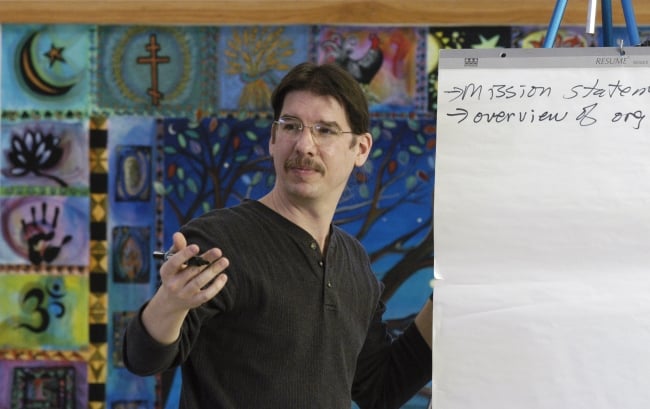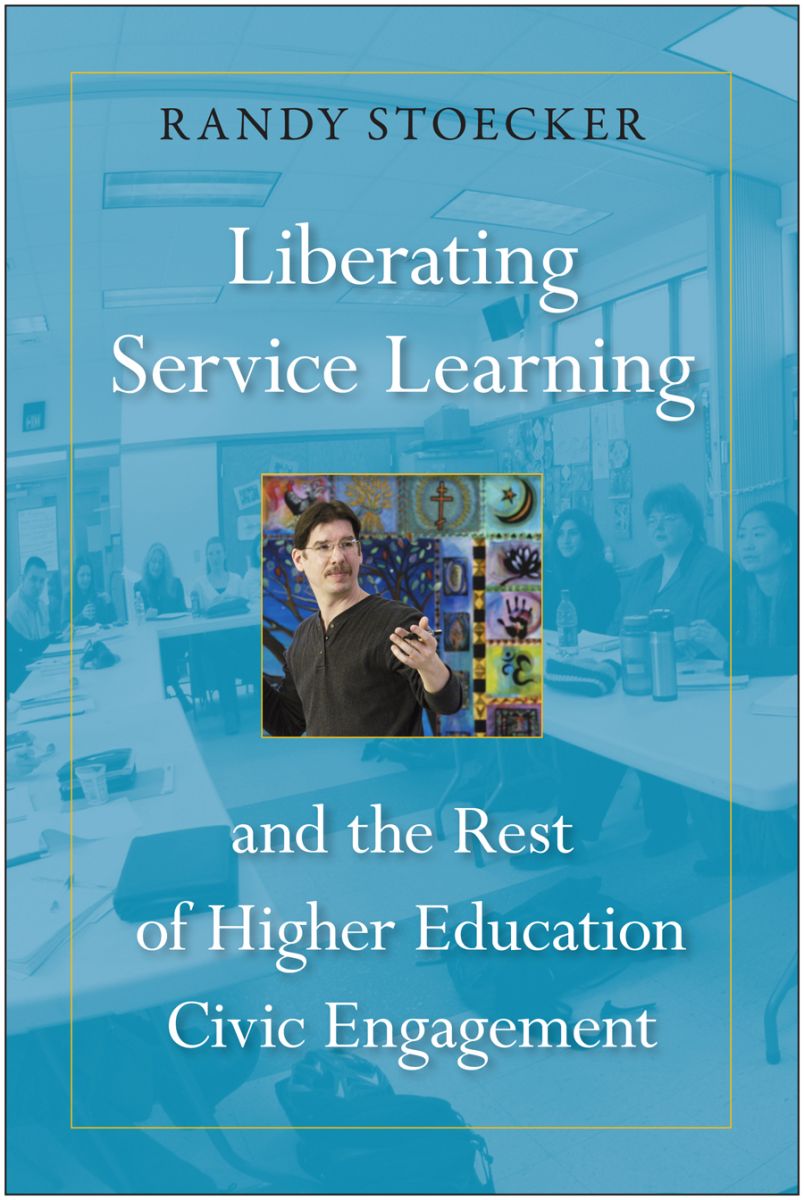You have /5 articles left.
Sign up for a free account or log in.

Randy Stoecker leads a discussion on service-learning projects.
The University of Wisconsin at Madison
At the awards banquet, one student wore a union T-shirt under a loose button-down.
He was not an honoree. The honorees -- students who had worked with children, animals, the elderly -- were volunteers. He was only there to set up the projector.
But beyond the awards banquet, he was an activist: the campus food service workers were trying to unionize, and the student and his friends were helping them.
“Here was a student working to support some of the lowest-paid, most mistreated and exploited workers in the country,” said Randy Stoecker, who had asked the student about his union T-shirt. “That, to me, is the most important kind of work.”
Why, then, didn’t he get an award? Did his work matter less? Stoecker sat through the dinner, wondering why the student and his friends weren’t honored.
Stoecker tells this story in his new book, Liberating Service Learning and the Rest of Higher Education Civic Engagement (Temple University Press). A sociology professor at the University of Wisconsin at Madison, he has been trying to do community engagement work with students for decades -- but he kept running into the same problems. On college campuses, service learning was too unproductive. Too student-centric. Too safe.

But perhaps worse, Stoecker argues that institutionalized service learning focuses more on “learning” than “service.” That it prioritizes students -- and what they learn -- over the communities they try to help.
As a result, programs mistake the output (what the students did) for the outcome (whether they accomplished their goal). Even in more directed efforts, many programs fail: if the food bank’s goal was to promote nutrition, counting the number of people who came won’t tell you much.
Institutionalized service learning is obsessed with counting, Stoecker writes. Students count their hours. Programs count their participants. When community members or nonprofit organizations are surveyed, they’re often asked only whether they liked having a service learner around. They aren’t asked about results.
“If we ran medical schools the way that we run service learning,” he said, “there would be a public outcry.”
‘What Classrooms Are For’
But what if, say, fire departments were run like service-learning programs? Stoecker poses this question midway through the book, and he spends two pages listing answers:
The firefighters would fight fires only for set hours. If your fire lasted longer, you would just have to try to put out the rest of it yourself.
They wouldn’t want to fight fires far away from the fire station.
There wouldn’t be any training. In fact the purpose of fighting fires would be to provide training. If your house burned down in the process, it would still be good training.
When Stoecker wrote up this comparison, he was discouraged: he had recently witnessed people who had “literally suffered at the hands of service learning.” He wouldn’t go into detail -- he hasn’t asked the community members for permission to tell their story -- but the situation brought the analogy to mind.
How could service learning cause harm? When the focus is on learning, students and professors operate as if they’re in a traditional learning environment -- namely, one that allows for failure, experimentation and mistakes.
“That's what classrooms are for: classrooms are for students to make mistakes,” Stoecker said. “Communities are not places to make mistakes.”
The focus on students, Stoecker writes, shows through in the language of mission statements, of research, of website copy. “Learning” is mentioned frequently; “community” is not. When it is, it’s spoken of as a “partnership,” as if the partnership itself were the goal.
And after a program ends, it’s the students’ work that’s measured. Whether their work accomplished something -- or made something worse -- isn’t always a priority.
"We are better at measuring the outcomes for students than we are at measuring the outcomes for communities,” said Andrew Seligsohn, president of Campus Compact, a coalition of colleges devoted to civic engagement. “Collectively, we need to get better at that.”
At the same time, Seligsohn said, efforts to change this are in the making. Democracy Collaborative, for instance, is testing a set of indicators designed to measure how campus service programs affect communities.
Still, he said, “I don't think we’re anywhere close to where we need to be.”
Charity and Change
“I believe in anger,” Stoecker writes to begin the final section of his book. Rather than irrational, violent anger, he’s talking about a “cold” sort of anger: an anger directed at systematic failure. It’s also an anger that opposes the emotions rooted in charity -- sadness, pity, blame.
“Charity is disrespectful in many ways,” he said. “It recognizes people as needy rather than as suffering from an unjust system.”
Many service-learning programs repress that anger, he argues. That’s why colleges focus on uncontroversial causes and why they aren’t comfortable with more politicized, activist work.
“It's a fair critique,” Seligsohn said. “It's easier and more comfortable to support students who are simply out helping other people. It's not controversial.”
At the same time, Seligsohn said, students need to learn that they will encounter opposition through their activism. Staging a protest means intentionally raising the level of tension, and it means challenging authority. “One of the ways that you learn how to be an activist,” he said, “is by practicing it.”
But service learning rooted in charity -- the kind that gets honored at awards banquets -- often helps communities cope with an unjust system, rather than helping them change it, Stoecker argues. For some campus leaders, there’s a tension between fighting systematic oppression and meeting people’s immediate needs: If they focus on the causes of food insecurity, what about the people who are hungry now?
Many campus leaders believe in striking a balance. “We’re educating students to be compassionate, engaged individuals, who will then take the reins on some of those bigger-level issues,” said Kim Jensen Bohat, director of Marquette University’s Service Learning Program. At Marquette, some efforts focus on direct service, while others focus on advocacy and change.
For Stoecker, best practices always involve giving the constituencies control. Imposing community service on others reinforces power imbalances; the service is controlled by the college, and the communities are defined by their need for outside help.
Instead, he writes that service programs should empower communities -- and in the classroom, students should learn how to most effectively achieve that goal.
“I'm all for helping student learning,” Stoecker said, “but not on the backs of communities.”




